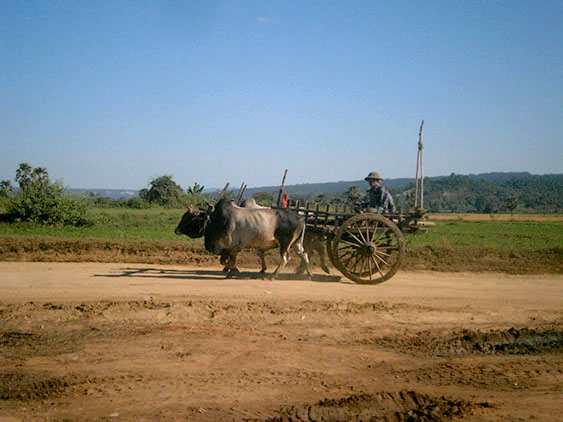
Burmese with a cart
25.11
We enter Burma – now officially Myanmar: a country we don’t know almost anything about. What we know is that it is a Buddhist country and after many years of military dictatorship and a few days ago the elections were won by a democratic leader: Aung San Suu Kyi who had spent many years as a political prisoner and won Nobel Peace Prize. All the travelers we met who had been there were very impressed by the country and said it’s very special and the people are extremely hospitable and nice. This is all the information we have for now.
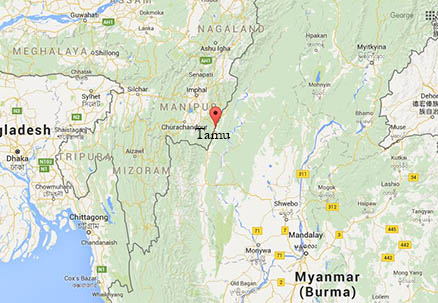 They stamp our passports at a small exotic-looking building. They check our special permit we need to cross the border and tell us to wait for a guide who will take us. We tell we are heading on foot to Tamu Village and we don’t need a guide. They let us go. Tamu is 3 km. away from the border and the road is calm with just a few motor bikes passing by us. Twenty minutes later a guy with a small scooter stops by us and offers to take us to the center for free. We hop on the scooter together with our rucksacks and we are in Tamu in no time.
They stamp our passports at a small exotic-looking building. They check our special permit we need to cross the border and tell us to wait for a guide who will take us. We tell we are heading on foot to Tamu Village and we don’t need a guide. They let us go. Tamu is 3 km. away from the border and the road is calm with just a few motor bikes passing by us. Twenty minutes later a guy with a small scooter stops by us and offers to take us to the center for free. We hop on the scooter together with our rucksacks and we are in Tamu in no time.

Entering Tamu
The guide is a boy with heavy metal t-shirt wants to put us inside a bus to Kalei because in his words we can’t stay in the border region between Tamu and Kalei. We tell him that we plan to have lunch first and will catch the bus later. The boy leaves happy that his obligations toward us are finished. We continue walking towards the end of the town, but there is just an endless row of houses. We walk for an hour and at last stop and start hitchhiking. There are many cars and other vehicles, but nobody stops. After an hour a truck loaded with Chinese goods takes us. The driver who was changed by a boy in the next village is going directly to Kalei which is 150 km away. The boy is very nice, but doesn’t speak English so we don’t communicate much.
The minute we crossed the iron bridge on the border a whole new, totally different world appeared in front of us. We couldn’t believe how things could be so different starting from the other end of the bridge. Views are amazing. We are in heaven. Cleanliness, calmness and silence take us over. Wonderful forests, rice fields, palms, small bamboo and wooden houses form a heavenly view.

Typical house
Every house is separate with its own backyard including even those the central part of the villages contrary to the Indian villages where houses are very close to one another and don’t have yards. We realize that the noise and all the craziness in India together with the dust and the dirt have been affecting us subconsciously and now Burma elates us and is like a heavenly nectar to our minds and nerves.

On the road
Everywhere we see clay pots for water from which the passers-by drink.
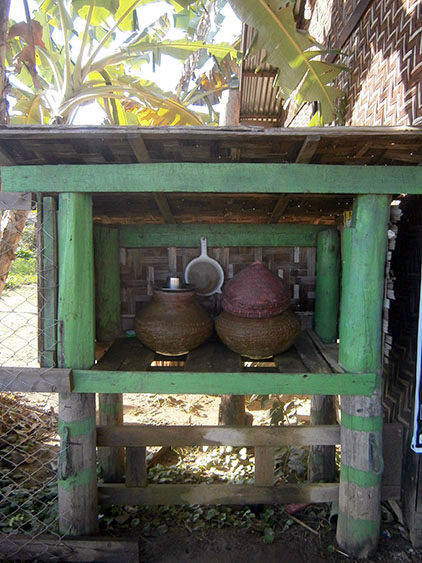
Typical earthen jugs on the streets
Everything is so well-arranged and fairy-tale-like. The usage of concrete and bricks in construction obviously is small to non-existent. Women wear a piece of cloth as shirt or skirt and the faces of many of them are covered with a yellow face pack the material for which they exert from a special tree that they rub in a smooth stone. They put for sun protection and beauty. Their skirts are not so colorful and beautiful as those we saw in Manipur and look more like saris.
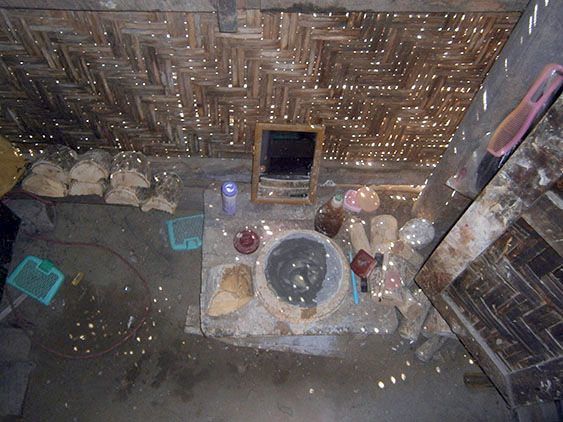
Dressing room for thanaka
Video: preparing thanaka face pack
Men also wear skirts – usually brown or blue, always checkered, but the way they tie them on their waist is very different from the one we saw in India. Everyone here love checkered cloth design. Chewing betel is very common activity here – even more than in India. Men also smoke some green-leaf cigars. People seem calm and friendly.
Video: how betel is prepared (pat two)
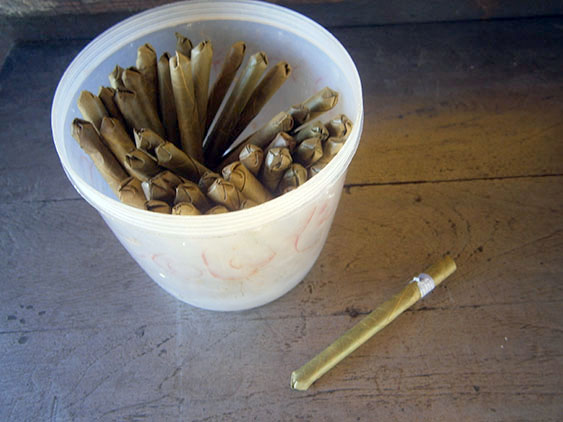
Burmese cigars
Something new to us are the beer houses which are present even in the smallest of villages. Everywhere here local beer and other kinds of alcohol are being sold and it is very common for people here to drink a beer at lunch – something unthinkable in India. Something else we didn’t expect to see was that the whole region between Tamu and Kalei was full of churches.
The road is good and in the evening we reach Kalei. It turns out we have to go back 10 km. because we missed the fork for Mandalay and Kalewa. We head back to the town’s exit. A Spanish guy told us that people here were not allowed to accommodate you at their houses because it is illegal – but regardless of this everyone tries to help you. We also know that people are not accustomed to seeing tents and are confused when they see one.
There are just houses and rice fields around us so we can’t find a hidden place for the tent. On the other side all looks idyllic so we think there probably won’t be a problem. While we are walking we notice a big Buddhist monastery. We know from experience that at the non-touristic places monasteries almost never decline to accommodate travelers. So we decide to give it a try.

The place where the monks live
One of the senior monk agreed immediately and they accommodate us in a big, brand new room. They give us blankets and pillows as well as two bottles of water. Behind the building there are bathrooms and toilets and a small yard used by the monks as kitchen. Nobody comes to bother us or ask us anything… besides a monk who came only to ask us if we are happy 🙂
In the evening we get up to pitch the tent because there are many terrible mosquitoes. We spend a nice first night at Burma.
26.11
In the morning we go around the monastery. Inside the meditation room there are a dozen of people – monks as well as ordinary people who all meditate under anti-mosquito nets. We also indulged ourselves in a one-hour morning meditation and after we are all finished they invite us at breakfast in a big room. There is one table where food is served, but it is just for us nobody else will eat. We don’t know whether they have eaten already or they just don’t have breakfast.
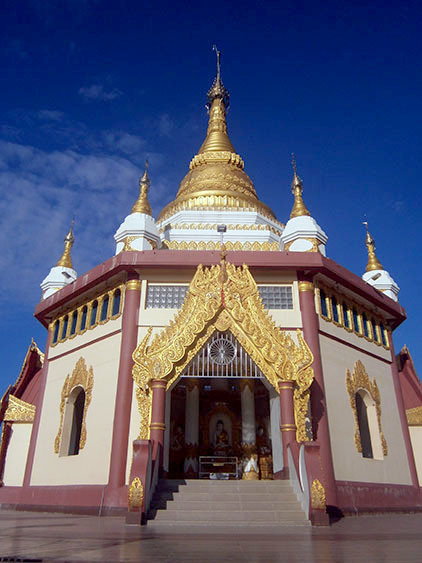
First monastery
The food is noodles with many strange vegetables and other stuff including meat. We put the meat away and eat, but not much because the taste of the food is too strange. There is also tea with milk and something they call coffee, but doesn’t taste like one at all. The said beverage is served in thermoses and is offered in all restaurants.
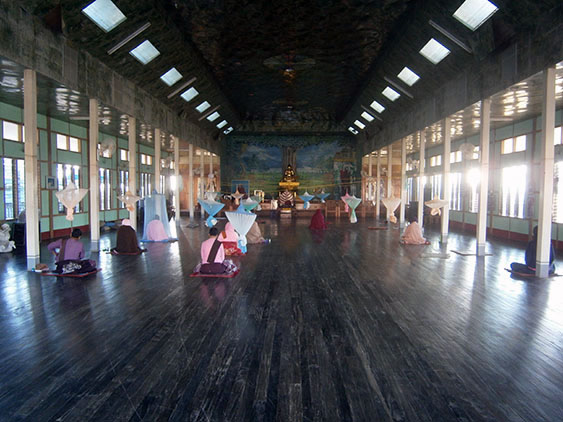
Meditation room at the monastery
We pack our rucksacks, read a little and at 11:00 a.m. we go to tell the monks we are leaving. They are all at a queue in front of the dining room. It turns out it is lunch time. They invite us to eat with them. Before they start eating there is some kind of ceremony they perform: singing prayer. Then the monks start eating and the ordinary people wait for them aside. When monks finish eating the rest sit to eat.
They put us on a separate table while monks are eating – maybe because we are their guests. There is so much food on the table that we can’t believe our eyes. It is gathered by the monks in the morning when they go out with their baskets and stand in a line. Then people come and put food in their baskets: cooked meals, biscuits, raw food, snacks, fruits, etc. – all one can think of. Then the food is put in order in the big dining room.
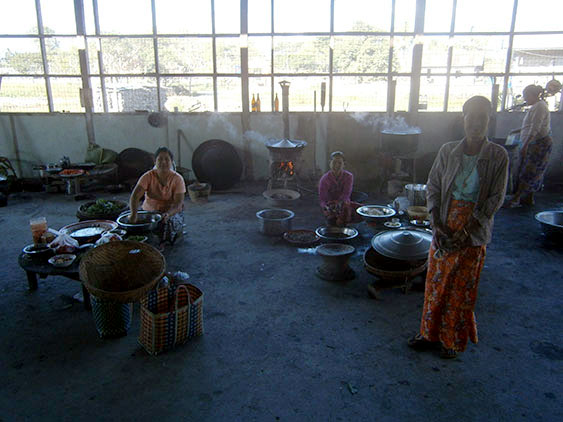
The kitchen at the monastery
This custom is also popular in Thailand and Laos. On our table there are at least ten dishes with different kinds of vegetables, meat, fish, soups, salads, served with white rice. The taste of everything in Burma is very different from all we’ve eaten in India. I always wonder how monks in the South-east Asia eat meat with clean conscience when Buddhism preaches non-violence towards all living beings.
In Sri Lanka for example where everyone belong to Theravada Buddhism all are vegetarians – even the ordinary people. So we eat so much delicious food that we don’t get hungry till the evening. Maybe that is the idea of eating abundant lunch. Monks usually don’t eat after in the evening.
We start hitchhiking. We wait 20-30 minutes because there are not much vehicles passing-by. At the end a truck takes us, going directly to Mandalay, which is 400 km away. Views are amazing here too and we are flabbergasted by the landscapes. We truly think that this is how paradise should look like.
At some places we can still see the effects of the flood they’ve had here earlier this year. Whole houses turned upside down and camps of people who lost their homes next to the road. Until recently there were many places without bridge and traveling had been terrible they told us, but obviously the region is recovers fast. I can’t imagine what it was: the level of the river had risen with 10 meters and stayed like this for 11 days. It had been a real tragedy!
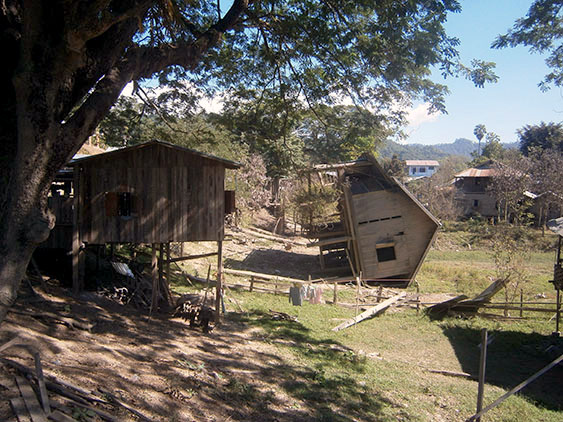
After the flood
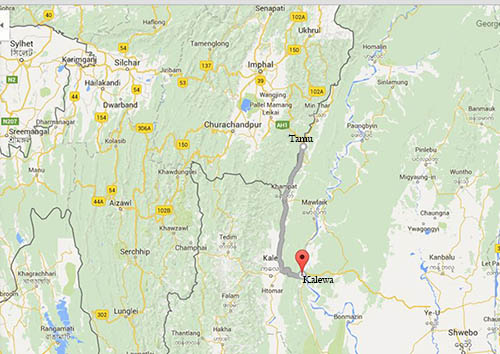 We near Kalewa and a policeman stops the truck for a check. We’ve heard hitchhiking is forbidden here, but the policeman just asked us whether we will travel to Mandalay with the truck and let us go. The road from Kalewa to Monywa is 184 km and passes through a hilly region, which is not very inhabited. Soon the asphalt on the road disappears and we start moving with 10-15 km/h so we cross just 100 by the evening. The scenery is so great that we don’t really care about the speed we travel with.
We near Kalewa and a policeman stops the truck for a check. We’ve heard hitchhiking is forbidden here, but the policeman just asked us whether we will travel to Mandalay with the truck and let us go. The road from Kalewa to Monywa is 184 km and passes through a hilly region, which is not very inhabited. Soon the asphalt on the road disappears and we start moving with 10-15 km/h so we cross just 100 by the evening. The scenery is so great that we don’t really care about the speed we travel with.
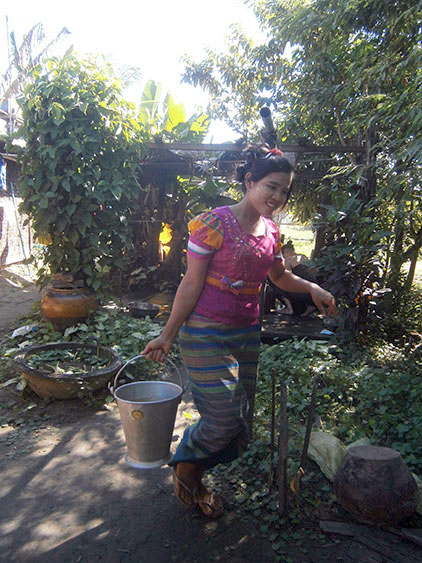
Burmese woman
At 6 p.m. it start getting dark and we ask the driver to stop us at a restaurant by the road. We need water so we couldn’t get off in the forest. He gets really occupied and tries to convince us to continue with him, but we don’t want to travel all night so we stay at the restaurant.
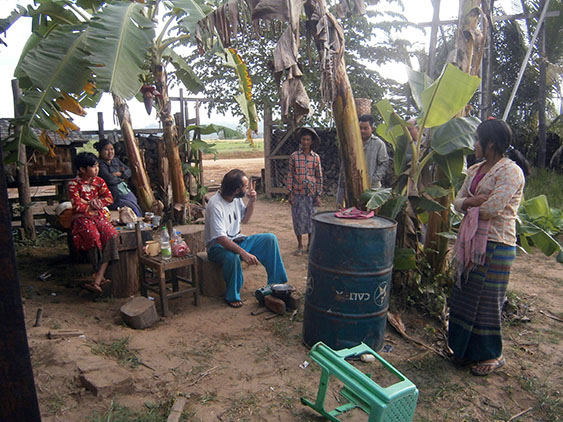
Communication with gestures with the locals
After quite a fuss the people tell us we can pitch our tent under a palm in their yard. They laugh all the time and watch us with immense interest. Mr. Shushtari even said that at a certain point it seemed to him that the owner of the restaurant offered him to sleep with his sister. We go to bed without having dinner because we still aren’t hungry because of the monstrous lunch we had.

The kitchen of the restaurant
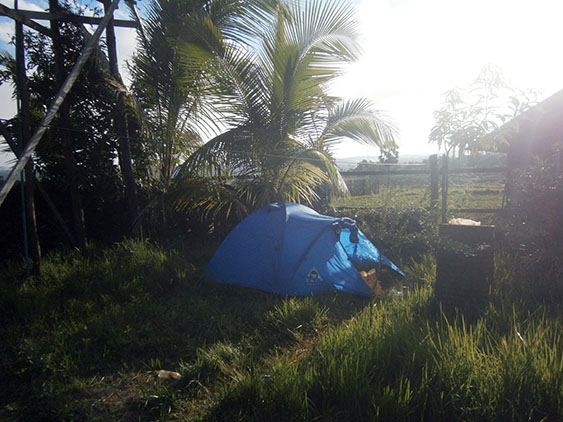
Sleeping at the backyard of the restaurant
27.11
We take a shower in the morning, launder our clothes and we are off. People give us bananas and caramelized balls of rice with a piece of hard peanut butter. On the nearby road we saw that just two cars and two trucks passed. We head on foot to the exit of the village and just 5 mins later a jeep going to Monywa takes us.
We stop to eat at a village and they treat us to lunch, which again is white rice with at least ten different meals. Everyone drinks beer at lunch and then we continue. The car is jolting horribly and there are many bends, all of which makes me sick. Good that this leg of the road is just 30 km. and when we get on the highway in the valley we cross the next 60 km in no time.
Monywa is relatively small. Behind every corner we see sparkling golden pagodas and Buddhist monasteries. Street vendors sell many kinds of exotic foods. All women wear the yellow face pack, which by the way I started to put on too. The women here are very happy to put this on my face because they think it makes you more beautiful.

Grandmother with her grandchild
People leave in the beginning of Monywa and it takes us an hour to reach the other end. Everything is very interesting and exotic and we are impatient to set our bivouac and start going around. What we didn’t expect was that everything would be so well-arranged and developed. Maybe in several years the country will become like Thailand.
 A truck takes us to a small town half way to Mandalay. It starts getting dark and we decide to enter the first monastery we see. At the end of the town called Myiunmu we see one and go there. The main monk tries to send us to a hotel, but then agrees to accommodate us and checks our passports thoroughly.
A truck takes us to a small town half way to Mandalay. It starts getting dark and we decide to enter the first monastery we see. At the end of the town called Myiunmu we see one and go there. The main monk tries to send us to a hotel, but then agrees to accommodate us and checks our passports thoroughly.
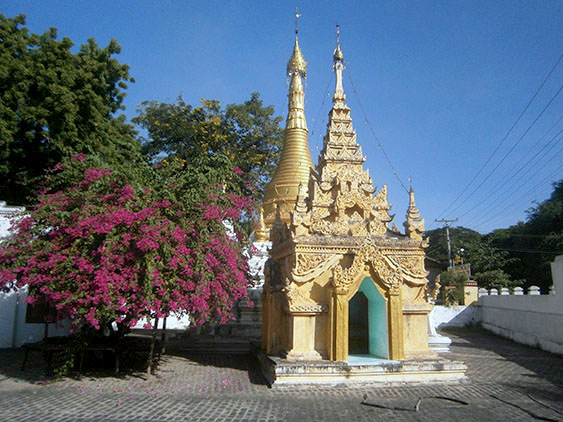
The monastery at Myiunmu
Then other monks give us bananas and take us to a big room where also live several teenagers. In one of the buildings there is a monk school and a few monk kids are reading sutras. There are several other gorwn-up monks and obviously the monastery is a kind of educational center. The boys in whose room we were accommodated were wearing everyday clothes and we couldn’t understand what they were doing here.
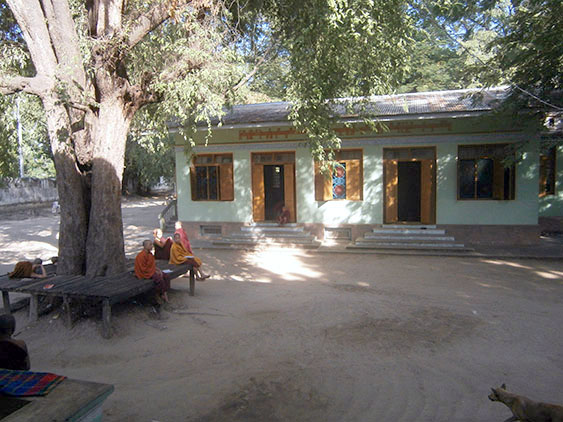
Monks and students
In Burma every boy has to be a monk for at least a week. Maybe this monastery is school for “temporary” monks. The boys we are with call all the time to girls and listen to music till late. The night is warm and considering we are headed south maybe the cold nights are over for us.
28.11
Today we use Myanmar kyat (the local currency pronounced chats) for the first time. We have 100 USD in cash that we want to exchange in Mandalay. Joan, the Spanish guy who travels without money, gave us a bill of 1000 kyats (around 0.70 eurocents) which he too received as a gift. We are inspired by his experience and have decided to try traveling without spending money.

Morning shower
Today is the third day that we don’t use money and rely on the goodness of the people and the provisions we have left from India, which are not much. We haven’t eaten anything for dinner, it looks like we won’t have a breakfast so we decide to but something with the 1000 kyats. We buy noodles, a little red rice and traditional jam – each thing costs around 330 kyats (0.25 eurocents).
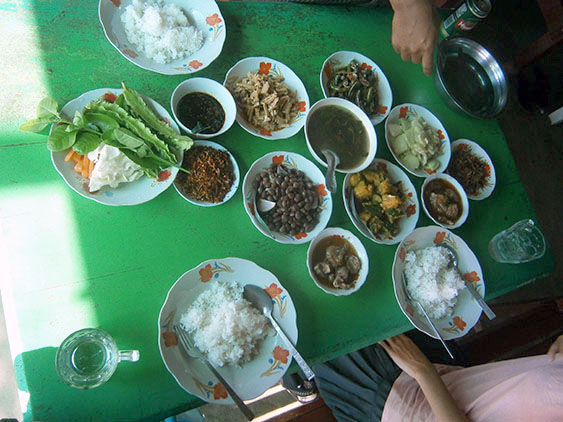
Our first feast
After eating we go out on the road and 20 minutes later a jeep with several boys in it stop and take us directly to Mandalay. We are riding at the back and we pass the 70 km. without noticing.
Mandalay is the second biggest city in Myanmar after Yangon. There are many landmarks in the area so it’s very touristic. We wonder whether to see the main landmarks rapidly and then look for a monastery out of town or to go search for a monastery where to stay first. We are entering the city when the boys say that they will take us to “their” monastery. We park at the yard and they call the abbot and everyone falls down at his feet. He accepts us joyously and the boys leave.
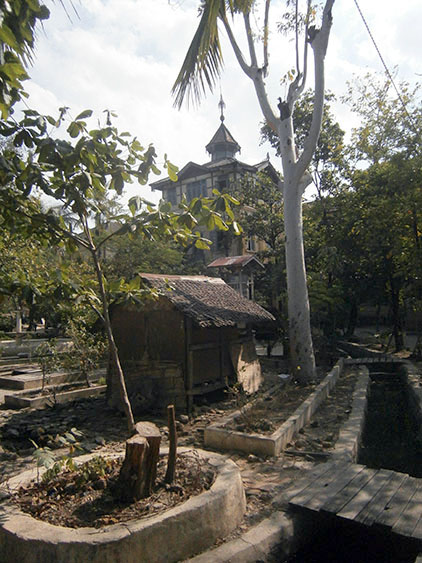
The orphanage
We don’t know it but this is the beginning of a wild experience for us. The abbot, a slim old man with glasses, takes us to a colonial building, which is being renovated at the moment and is empty. They clean a room for us, bring two tables and several chairs as well as a carpet. We pitch the tent (mostly because of the mosquitoes and a child comes bearing huge tray full of fruits – tangerines, bananas, dragon fruit and a pack of mineral water bottles. We can’t believe how lucky we are. In front of our window we see palms moving slightly from the wind – a real tropical idyll. The abbot says we can stay as long as we want and smiles friendly.

First gifts from the monks
We unload our baggage and go out for a walk. Mandalay is pretty big and distances are long, but luckily we are near the major landmarks. The city is nice. There is tropical vegetation everywhere, little traffic, low buildings and wide streets that are perpendicular as in the USA (for example certain address is on 6-th and 35-th).

Giant statue at the close-by monastery
Soon we reach the king’s castle surrounded by wall and water canal. The ticket (that can also be used for other landmarks) costs 10 000 kyats (7euro) and is unaffordable for us at the moment. Regardless of this we feel so happy that we have the privilege to walk around Mandalay that we don’t care. We continue and climb the nearby hill from where we can see the whole city. It’s beautiful.
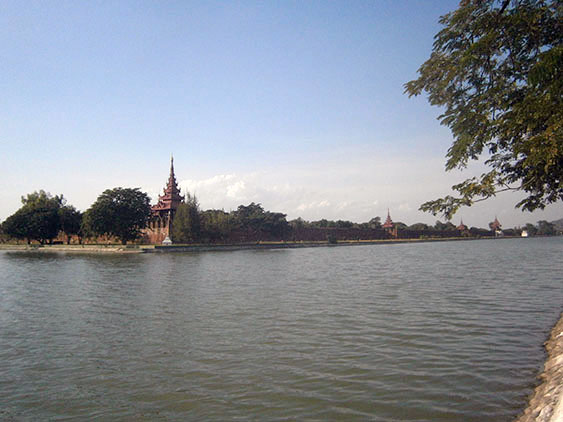
The king’s palace
At the foot of the hill we see three old pagodas that we can visit for free. We entered maybe six till now, but they are so beautiful that we can’t get tired of them. Golden dome structures, statues of Buddha, monks in red robes, palms, pink sun-set – all of this makes us feel as if we are in a fairy-tale. The feeling of being in paradise is strong again.

The biggest book in the world – there is a stone plate in each stupa with Buddhist texts
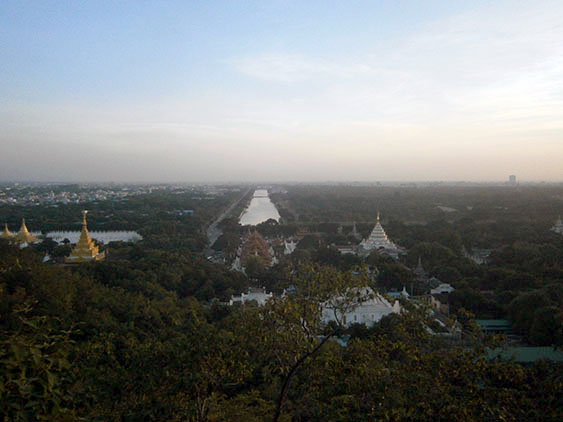
View from Mandalay hill

Sanda Muni Pagoda
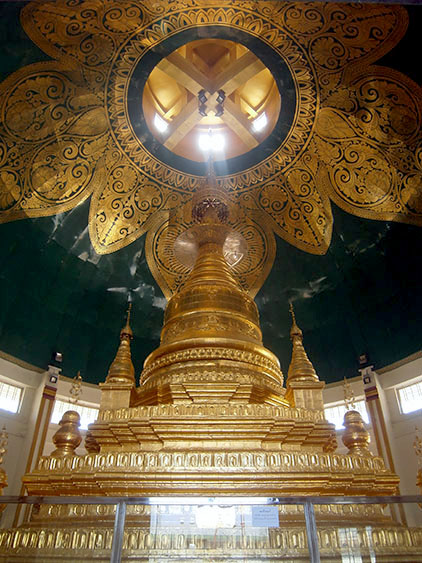
Aung Taw Mu Pagoda
We go back at the monastery (which is also an orphanage) in the evening and a boy calls us for dinner. The table is full of variety of dishes and rice. We feel uncomfortable. A corpulent monks comes after we eat till we are almost dead and offers us a bag of snacks, chips and energy drinks to take for the room. We speak a little bit to the boys and it turns out this is a Buddhist sanctuary for homeless children found 1926. There are two monks here and the abbot. There are 200 kids from all ages, but they don’t study to become monks. All are well dressed and have smartphones. They have primary school at the monastery and the bigger kids go to other school. The atmosphere is great and they all look really happy. We talk about politics and as all the people we spoke about this topic they too are very glad that the military regime is over and they will live in democracy.
The problem is that their English is basic so we can’t have more elaborate conversations. Burma is former British colony, but contrary to India one can barely notice this. The signs in English are rare, though they use the British way to measure distance – namely miles and yards. Cars drive on the right side of the road, but the steering wheels are on the right side of the cars so driving and taking over other cars is a little bit dangerous since the driver has to get the whole car on the other side of the road in order to see. Thanks God that Burmese are calm and good drivers so the really dangerous situations are rare.
29.11
After another superabundant breakfast the abbot asks us if we want to be taken to some landmark. We’ve heard that the Maha Muni pagoda is the second important religious place in Burma and we wanted to see the Buddha statue that is made of pure gold, but it was at the other side of the city so it would have been difficult to go there. So we agree imagining that some boys will take us there with their motor bikes.
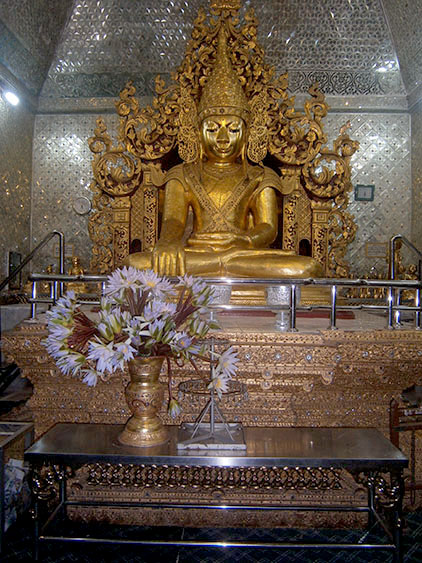
Buddha statue at Kuthodaw Pagoda
Instead of this a shiny, brand new jeep appears with a driver inside. We start feeling very incomfortable and try to explain that they may just give us bicycles and that will suffice, but everyone are just chuckling and pushing us to enter the jeep. Four of the bigger boys join us as well as the corpulent monk and we are a go. And what a tour it was…
Mandaly – the pagodas’ heaven
A giant gold Buddha statue attracts pilgrims from all over Burma at Maha Muni Paya. The visitors stick thin paper covered with fine gold dust on the statue and add micron by micron gold on it. The corridors around the pagoda, which are roofed have sparkling pieces of glass on them. There is a separate room with bronze statues of mythic beings that are said to cure maladies if one rubs in them.
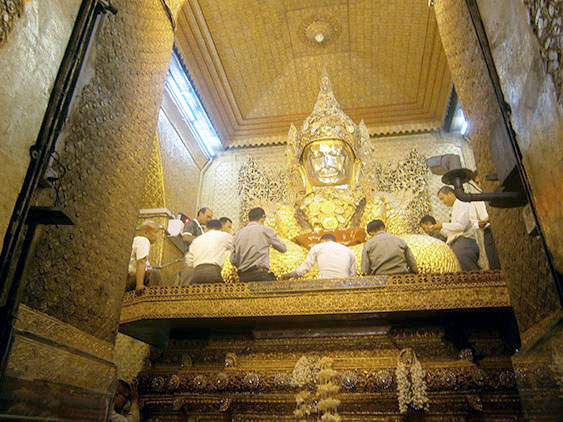
The golden Buddha at the Maha Muni Pagoda
Video: sticking gold paper at Maha Muni Pagoda
The ancient city Inwa, which is 20 km. away from Mandalay has antique temples and pagodas which amaze the tourists. They ask for tickets at the entrance and the corpulent monk buys two for us (7 euro each) despite our protests. The Burmese enter for free.
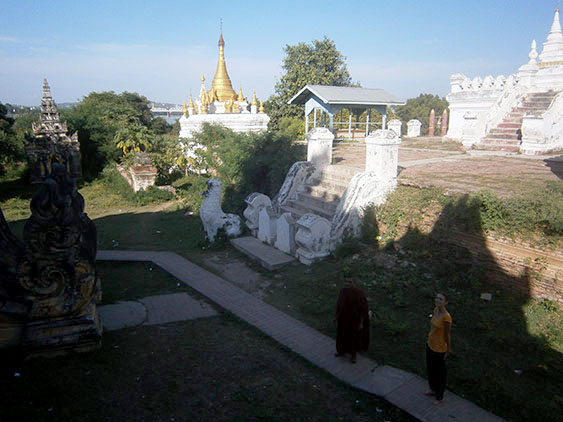
Inwa
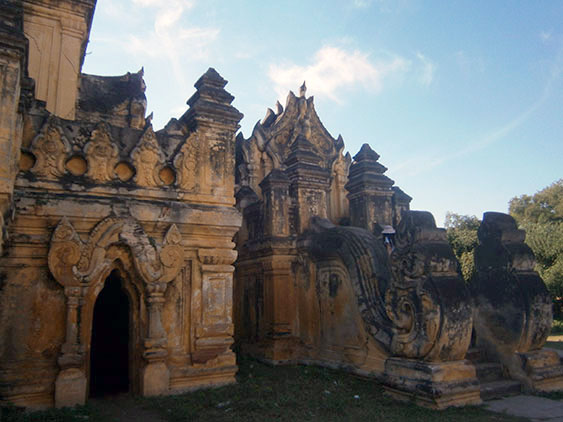
Inwa
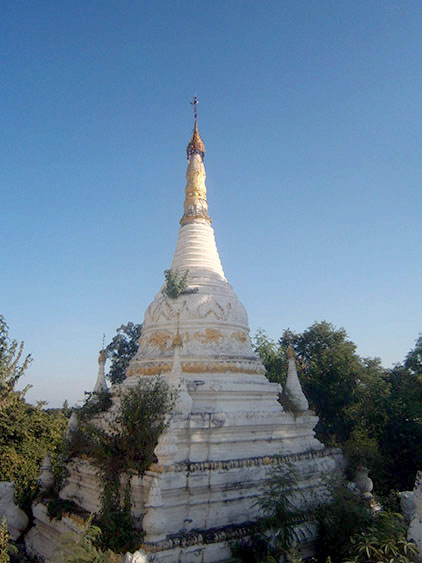
Inwa

Inwa
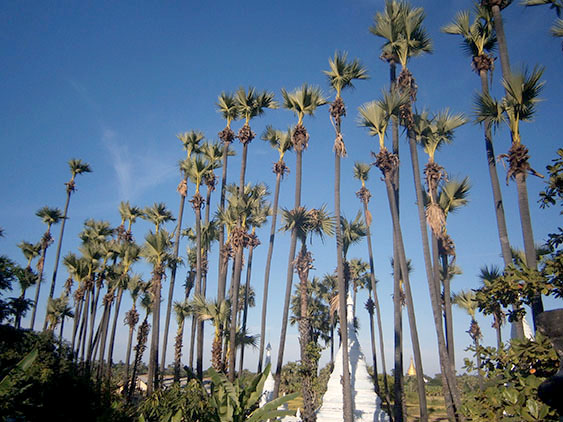
Inwa

At Inwa with our friends
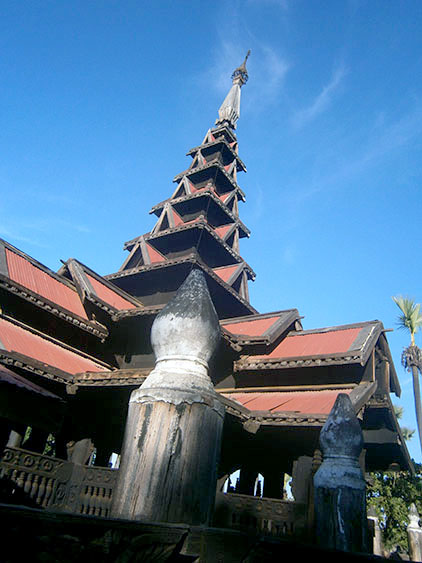
Wooden tikka temple at Inwa
We continue to Sagaing a small town on the other side of Ayeyawady River. Pagodas and monasteries line up before our eyes endlessly. Each one of them is huge, beautifully decorated, most of them golden, each one with unique architecture and style. We have never seen so many temples at one place even in India, and they are all in perfect condition. All of them are built with donations.
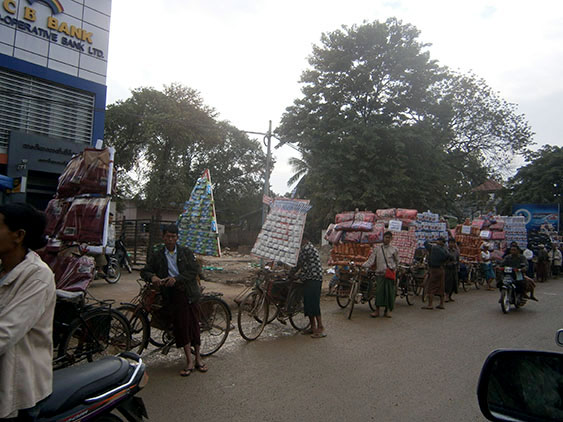
People bringing donations to the temples
Video: Procession of people bringing donations
Myanmar is the most generous country where people do the most donations and this could be seen clearly here in Mandalay. All the boxes for donations at the temples are filled with money. Some invest in shopping malls other in temples… There are very few malls in the central part of the city, but the gold, precious stones and incrustations of the pagodas would be more than enough to build more malls than there are in all of Bulgaria. But here they prefer to build temples, not malls 🙂

Kaungmudaw Pagoda, Sagaing (painted in gold after the elections where a democratic leader was elected)
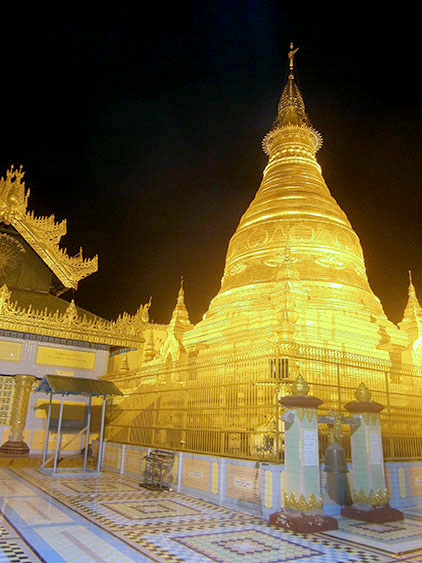
Pagoda at Sagaing
After Sagaing we continue to Mingun which is famous for a gigantic brick building in the form of a mountain. It has massive walls and some holes here and there for Buddha statues. It got split after a earthquake. The monk pays 3,50 euro each for us to enter and in the meantime the boys buy us souvenirs like crazy. We feel like we are at the most expensive tour ever that includes landmarks, jeep and gifts. If these people haven’t done such a great thing for us we wouldn’t be able to see anything in Mandalay. Most of the landmarks are far from each other, secluded and there is no public transport to them. There are no signs in English and the entrance fees for foreigners are too expensive for our budget.
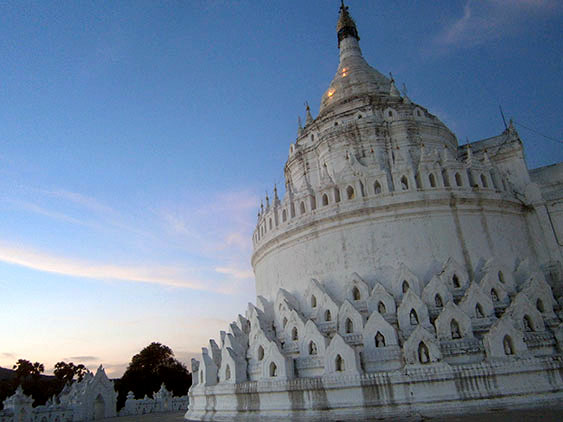
The White Temple at Min Gun

View from Min Gun
If you think we visited all from the monk’s list you are wrong. The next place we go to is a traditional wooden bridge made of tikka wood and crosses the whole Amarapura Lake. It got dark long ago and we are tired to death. But the tour is not over yet – the last thing we visit is the newest pagoda in Mandalay – the Jade Pagoda. It is covered in big pieces of jade – the rarest ones possible, I cannot even imagine how much this costs. There are jade Buddha statues at the four corners of the pagoda – of he best quality jade too. All the time I feel like I am dreaming. My head spins from gold, precious stones, Buddha statues monks and palms.

Irrawady River
In the evening the monks takes us to a restaurant and treats us to noodles. The boys are as happy as we are. We noticed that the monk often stops to buy rubber ducks and other toys for the little kids at the monastery. What an incredible day!
30.11-02.12
We feel like we are the most respected guests in whole of Mandalay. I think that even people in the best hotels are not treated so well. In the morning the breakfast is grandiose: rice, dozen of vegetable dishes, fruits, coffee with milk, tea and mineral water. Every time we try to explain that we can’t eat so much food and will be happy if they give us just rice and beans, but in vain. Three hours later there is lunch with even biggest variety of curries. The corpulent monk gives us biscuits and soda for dessert.
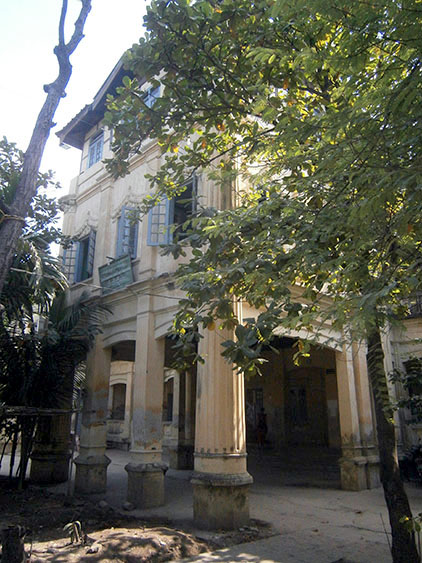
The place where we slept
Later the driver with the jeep takes us to visit two more landmarks. The expensive ticket from yesterday is valid also for the palace so this is the first place we go to. It is something like a miniature copy of the Forbidden City in Beijing, but made solely of wood. We are puzzled by the fact that the king lived in a small wooden houses that resemble barracks – maybe the original ones at least had engravings. These were made after the Second World War when the original ones were burnt.
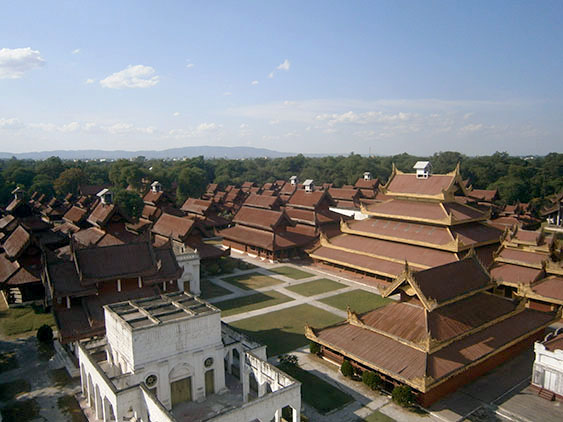
The king’s palace
Then we visit the Atumshi Monastery which is the biggest in Mandalay. The Buddha statue inside it is made of the dust left of the silk clothes of the king and is covered with gold. It also had a diamond on the forehead, but it disappeared while the country was under British rule. Next to it stands the king’s temple which is made of wood and covered in beautiful engravings.

Shwenandaw Kyaung Temple
After we finish the tour and get back home I start feeling strange. In the evening I have fever, but only my body was shaking, my head was cool. At one moment the shaking became uncontrollable and I start get nauseous, my belly swelled up. We came to the conclusion that is something related to the food – and no wonder having in mind all the strange dishes we ate (some of them were seasoned with fermented fish oil, there were also some gigantic beans) I couldn’t sleep all night because of the pains.
I am much better in the morning but I don’t eat anything except a banana. The abbot is worried it may be malaria. The disease is common here and there are these mosquitoes everywhere so it’s possible, but we tell him not to worry. He brings us traditional medicines that have terrible taste, but helped, and a jar of honey and Danish sweets. They bring many trays of food but only Mr. Shushtari eats them because he is OK. People here are so kind that even the grumpiest person would feel a heart-melt. We stay one more day in order to recover fully. I eat just fruits the whole day, but at least I am fine after the second day.
03.12
We pack our luggage, eat some mhinga (traditional breakfast with thin noodles with sauce made of bananas and covered with nuts). It is raining for the first time we are here and we have to wait for the rain to stop. We thank to everyone upon leaving. The abbot gives us umbrellas, dreid bananas and a box of superexpensive butter from New Zealand – we can’t even imagine where they have this from.
We head to the portal thinking how we will get out of the city when to our horror a green jeep opens its doors and everyone tell us to get in. We protest and try to tell them that we can manage on our own. Finally we agree to be taken to the highway. After we get to it the corpulent monk and three other boys who joined the trip tell us that they will take us to the fork for Bagan – our next destination.
We reach it and then worries creep in our minds… The driver puts 30 liters of gas in the tank and we stop for a lunch at a village which tell us they won’t leave us. After lunch we tell them we will continue hitchhiking but they don’t understand us because of the language barrier and we head to Bagan. We already feel uncomfortable they will pass 200 km. for us and try to convince them again to leave us but it seems they have decided not to.
On the way we stop at a monastery related to the sanctuary. The main monk invite us to tea and peanuts. We have barely taken a seat when they start with the gifts. First a bucket full of a medicine made of beans that they say is good for the liver and AIDS?! Htet Win, the boy we became closer to, asks us if we are HIV positive: Do you have the virus? – are his exact words. Though we say we don’t they anyway give us a bottle of the medicine and tell us to drink from it every day because it is good. The monk also gives us a jar of honey with seed and bananas. We bow to the ground and the visit is over.
Four hours later we reach Bagan. Bagan is the most famous landmark in Burma and respectively the tourist are the most. The ancient capital has 2000 temples and pagodas and some of them are 1000 years old. The way they are built among palms create mystic and unique scenery. We recommend the movie Samsara where you can see many views from Bagan.
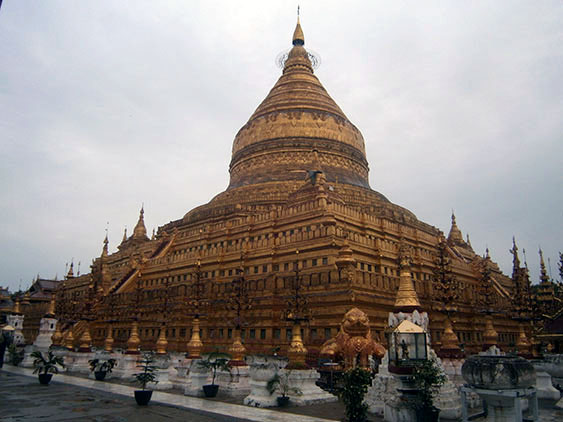
Bagan Shwezigon Pagoda
Entering the city I think I saw a sign where it said that all foreigner should buy tickets, but we just passed by it and nobody stopped us. We have heard that the ticket is quite expensive. We stop at a monastery where our friends have friends they want to greet. It turns out monasteries here are forbidden to accommodate foreigners and one has to sleep at the hotels (10-15 USD per night).
We don’t want to sleep in a hotel when there are pristine forests everywhere here with no houses or people around them. Our friends become worried because they want to find us a place to sleep at. Finally we agree to see the main pagodas and then to go back to the monk who gave us the AIDS cure just to relieve them from worries. It gets dark slowly and this turns out to be good news. No one asks for tickets anymore, there is nobody and the atmosphere becomes very mystic.
For four hours we manage to see all the pagodas which would have been impossible if we hadn’t transportation. Distances are huge and even with a bike it would have taken us at least a whole day. After the fifteen-th pagoda we are dead tired and we hope that the endless landmark list of the corpulent monk is coming to an end. I think I am so saturated with sightseeing that I won’t want to see any landmark for at least a month.
Regarding Bagan – I won’t even try to describe it. The place is mind blowing and a must see. No photos or movies could recreate the experience. It was dark and we couldn’t take pictures, but anyway pics couldn’t capture the magnificence and the mysticism of the place.
At 9 p.m. we head back. We are supposed to drive two hours back to Mingyan, but things didn’t go as planned. We become victims of extreme goodness. We suddenly understand we headed in another direction. It turns out our friends decided we would go to Yangon tomorrow so they decided to takes us to some town on the highway in order to save us some traveling time. They plan to drive all night and we started this journey at 10 a.m. and stopped just for lunch and dinner. When we hear this we are terrified. On top of this we wanted to visit some other places before heading to Yangon.
We still have 20 days of the visa left so we are totally not in a hurry so we say firmly that we want to go Mingyan and don’t need any help. At the end they agree but we have already driven quite a distance and the corpulent monk decides to not go back on the same road but to make a half circle and do a night tour in Popa Mountain. As a result we drive 4 instead of 2 hours to Mingyan.
I am now on the verge of a nervous breakdown. We are four people at the backseat and I can’t lie down and in addition the road is bad. At midnight we have 20 km. left to the monastery and our friends decide to stop for dinner. They are doing all this in order to help us but instead feelings of anger and aggression are arising in us. Anyway we can’t get angry with them because they are doing this just to help us and sure they did.
Suddenly they say there is a monastery at the village and they know the abbot there so they ask us if we want to stay at the monastery. We are overjoyed. It is now past midnight and we enter the monastery. The abbot is happy to see our group. There is a dozen of kids adopted by the monastery sleeping on the floor. They give us a place on the ground and we take goodbye with the boys and the corpulent monk whose name is U Thuzarta.

The abbot from the monastery we visited at night
04.12
Captives of goodness
At 5 a.m. after a horrendous night during which we are either attacked by thousands of mosquitoes or under the wool blanket dying from the heat the monastery inhabitants wake up and start moving around. Despite the noise we are still half asleep because of the exhaustion.
At 7:30 we open our so heavy eye-lids. There are five monks next to us staring at us. I am extremely annoyed and try to keep at bay the urge to get up and start hitting people. The monks are smiling and telling us to get up. I wash my face and feel calmer. The morning at the monastery is great. There is breakfast served under a Buddha’s altar. It consists of noodles with chicken and fried batters.
The abbot is overexcited and all give us food non-stop. We try not to look at him as he spits red betel phlegm in his porcelain cuspidor. We have decided to leave the monastery as soon as we can in order to find a place to rest. While we pack our bags we see a car parking in front. The abbot has called someone and he is ready to take us anywhere we want. He stands before us with a big smile. We never refuse free transportation, but at this moment we panic.
We imagine how we continue with the endless tourist tours till midnight and then have abundant meals and wake up with food poisoning and someone pays the fees for the landmarks for us… We want to escape because we don’t want to have people worried so much for us. We want to hitchhike and be alone for some time.
We are captives of unheard of goodness for several days now. We tell the abbot we will walk. He gives us a bag of peanuts and biscuits and we bow to him. As a compromise we say we could be driven to the end of the village. When we are on the asphalt road we feel free.
 We take the same road we came from yesterday. We are decided to go back to the mountain through which we passed yesterday and find a secluded place inside. We don’t have enough energy for long distance hitchhiking. We need to be in nature for some time, wake up later than 5 a.m. and see no people. Yesterday the corpulent monks was speaking excitedly about this mountain but we couldn’t understand what is so special about it. It is 50-60 km away but there are very few cars on the road.
We take the same road we came from yesterday. We are decided to go back to the mountain through which we passed yesterday and find a secluded place inside. We don’t have enough energy for long distance hitchhiking. We need to be in nature for some time, wake up later than 5 a.m. and see no people. Yesterday the corpulent monks was speaking excitedly about this mountain but we couldn’t understand what is so special about it. It is 50-60 km away but there are very few cars on the road.
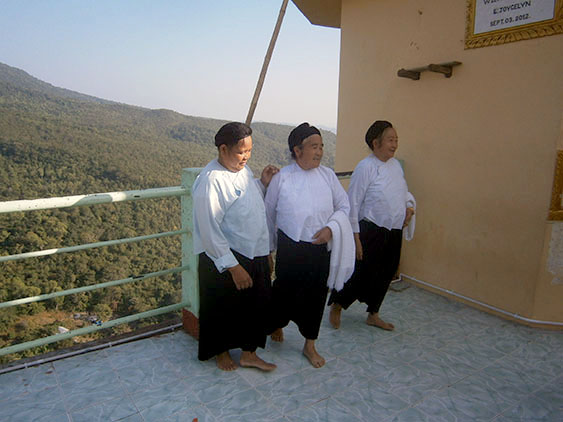
Mount Popa tribal women
Then hitchhiking starts smoothly and three cars alter we are at the foot of Popa Mountain. The mountain is in fact many hills in the midst of endless palm tree valleys. Narrow asphalt road leads to the top. We start walking up. On the road pass many luxury buses with western tourists and trucks with locals. We don’t know where they are all going. Half an hour later we climb more and we see a narrow cliff on which there is a pagoda. It looks impressive. Now we know where everyone was going.
We decide to not come any closer and turn aside a pathway. We climb on a hill with a nice view and where nobody could see us. We set our bivouac and relax. In the evening we cook the normal for us food: chapatas and lentils. The silence is broken only by a concert with Burmese disco music and Metallica which obviously takes place somewhere around the pagoda.
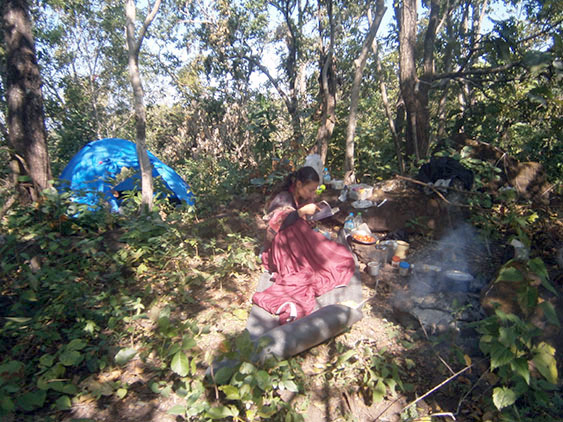
Our bivouac at Mount Popa
Hi ya, looks like you had a great time in Myanmar! So excited to get there. We are hoping to cycle through Myanmar from India and exit into Thailand. Your advice on getting the visa’s and permit for Moreh are great. I would like to know how you exited the country? Was it via land crossing or plane? It’s just we are running into resistance with folks saying – if crossing via land from India, you MUST exit via that same boarder. Any light on this situation would be great 🙂
LikeLiked by 1 person
We exited via land to Thailand. There is no such a thing that you must be back through the same border.
Enjoy your trip! 🙂
LikeLike
Hi,
Thank you for your comment 🙂 We exited by land going to Thailand (in fact 1,5 years we travel only on land and water). We write everything down so you can check exactly how we exited here: https://magickervan.com/2016/03/01/tough-nights-in-yangon-the-golden-rock-good-bye-myanmar-for-now-we-love-you-so-much/
Have a great journey!
LikeLike
Hey. Awesome artical. I’m looking to experience this myself and would like to know how to obtain flight tickets for getting a visa, which travel agency can do this for me? And as I have an Indian passport i would need to do the same in order to acquire a Thailand visa(I can get Visa on arrival but then I would have to show a proof for leaving, that’s why obtaining a visa in advance seems easy). So I really need your help. Please respond soon. Thank you.
LikeLiked by 1 person